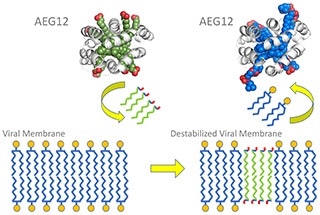Researchers at the National Institutes of Health (NIH) and their collaborators have found that AEG12, a mosquito protein, strongly suppresses the class of viruses causing dengue, yellow fever, Zika, and West Nile, while weakly suppressing coronaviruses.

The illustration of the viral membrane lipid bi-layer shows the water-loving heads (yellow circles) and water-hating tails (blue squiggles). AEG12, based on the protein’s crystal structure (green and gray), inserts some of its lipids (green squiggles) into the viral membrane, destabilizing it. During this exchange, AEG12 incorporates viral lipids into its interior (blue and gray). Image Credit: Geoffrey Mueller, PhD.
The researchers identified that AEG12 functions by destabilizing the viral envelope, disintegrating its protective covering. The protein does not harm viruses without an envelope, for example, those causing pink eye and bladder infections, but the study results could pave the way for therapeutics against viruses that infect millions of people across the globe. The study was published online in PNAS.
Researchers from the National Institute of Environmental Health Sciences (NIEHS), which is part of NIH, employed X-ray crystallography to resolve AEG12’s structure. According to Geoffrey Mueller, Ph.D., senior author of the study and head of the NIEHS Nuclear Magnetic Resonance Group, at the molecular level, AEG12 eliminates the lipids or the fat-like portions of the membrane holding the virus together.
It is as if AEG12 is hungry for the lipids that are in the virus membrane, so it gets rid of some of the lipids it has and exchanges them for the ones it really prefers. The protein has high affinity for viral lipids and steals them from the virus.”
Geoffrey Mueller, Head, Nuclear Magnetic Resonance Group, NIEHS
Consequently, Mueller stated that the AEG12 protein has powerful destructive powers over certain viruses. Although the researchers showed that AEG12 was most efficient against flaviviruses—the class of viruses to which West Nile, Zika, and others belong—AEG12 could even be effective against SARS-CoV-2, the coronavirus responsible for COVID-19 infection.
However, Mueller added that several years of bioengineering will be required to make AEG12 a feasible therapy for COVID-19. Part of the issue is that AEG12 also rips out red blood cells. Therefore, scientists will have to find compounds that can make the protein target only the viruses.
According to Alexander Foo, Ph.D., lead author of the study and an NIEHS visiting fellow, mosquitoes synthesize AEG12 when they consume a blood meal or are infected with flaviviruses. Similar to humans, mosquitoes present a strong immune response against these viruses, where AEG12 bursts their viral covering. However, during the start of the project, Foo and his collaborators did not know much about the functions of AEG12.
The prospect of studying a new protein is exciting, yet daunting. Thankfully, we had enough clues and access to a wide range of expertise at NIEHS to piece it together.”
Alexander Foo, Visiting Fellow, NIEHS
Lars Pedersen, Ph.D., a co-author of the study, is a crystallography expert and leader of the NIEHS Structure Function Group. He regularly uses information related to the physical composition of a molecule in his studies and inspires more researchers to consider the use of this data in their studies.
Our research shows that understanding the structure of a protein can be important in figuring out what it does and how it could help treat disease.”
Lars Pedersen, Crystallography Expert and Leader, Structure Function Group, NIEHS
Source:
Journal reference:
Foo, A. C. Y., et al. (2020) The mosquito protein AEG12 displays both cytolytic and antiviral properties via a common lipid transfer mechanism. Proceedings of the National Academy of Sciences of the United States of America. doi.org/10.1073/pnas.2019251118.